A 100-year “Wish” fulfilled: How Disney honors its legacy — and looks to the future — on the studio's centennial

- Oops!Something went wrong.Please try again later.
- Oops!Something went wrong.Please try again later.
- Oops!Something went wrong.Please try again later.
The dream weavers at Walt Disney Animation know what it means to wish upon a star. The concept and accompanying melody, written by Leigh Harline and Ned Washington for the formative 1940 film Pinocchio, has been woven into the very fabric of the movie studio. That gentle, soul-stirring jingle has consistently played over the Disney logo before every one of their movies for decades, to the point where the Mouse House and the tune are now one and the same.
"'When You Wish Upon A Star' was one of the first songs I knew. I don't even know when I first heard it. It just was always there," Jennifer Lee, co-director on Frozen and chief creative officer at Walt Disney Animation, reflects as she considers the studio's centennial. "You can say a wish is passive because you wish and hope this happens, but really it's a declaration of what's driving your heart, and the pursuit of that is important. How can we deconstruct that in a more sophisticated way, but also have a lot of celebration of the 100th?"
That became the goal — and challenge — for Chris Buck (the co-director of Frozen) and Fawn Veerasunthorn (the head of story on Raya and the Last Dragon) on their new film with an incredibly apt title.
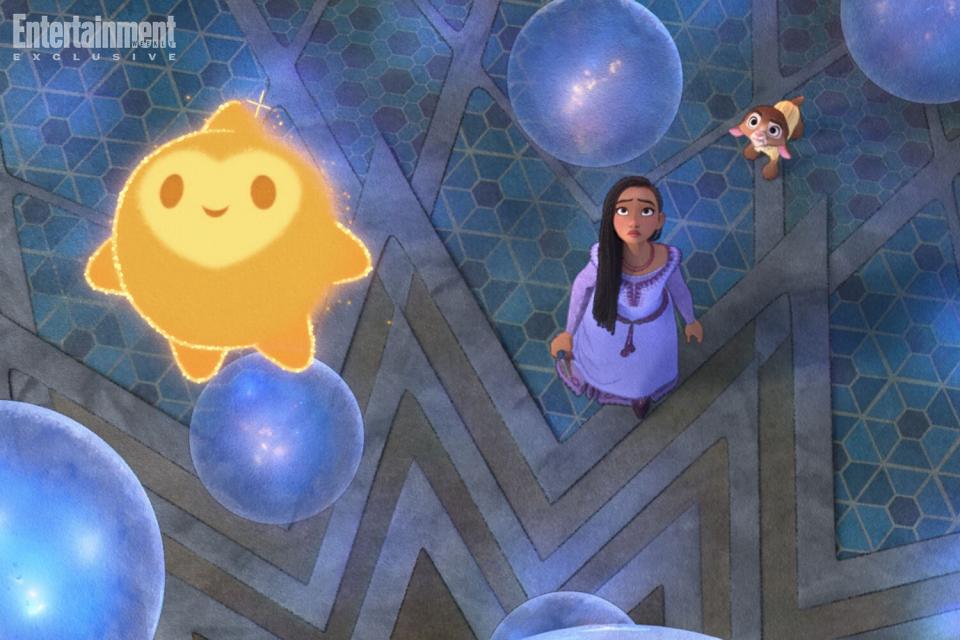
Disney Asha, voiced by Ariana DeBose, is determined to save the kingdom of Rosas in 'Wish'
Set in the island kingdom of Rosas, Wish (in theaters Nov. 22) follows the young and willful Asha (Ariana DeBose) as she fights to return all of the citizens' wishes, depicted as glistening blue orbs that have been locked away, never to be fulfilled by the ruling sorcerer, the vain and theatrical King Magnifico (Chris Pine).
Chatting with EW from inside the offices of Disney Animation Studios in Burbank, Calif., on the day they finished the final sound mix in October, Buck recalls feedback from early internal test screenings of their latest animated offering. "It was really hard for people to understand the power of a wish or how emotional a wish could be," he says seated next to Veerasunthorn beneath a framed drawing of Valentino, Asha's talking pet goat (voiced by Alan Tudyk). "That was pivotal. We knew we had to keep working to make it feel powerful."
Wishing seems to be on the minds of everyone at the studio as Disney marks its big double-O, commemorating a legacy that began in 1923 and looking ahead to what comes next. Those two ends of the spectrum have manifested in Wish, which personifies an actual wishing star as an adorable, whizzing-about character named Star, and Once Upon a Studio (on Disney+ tonight), a short film from filmmakers Dan Abraham and Trent Correy that sees Disney's catalog of wishful characters, from Mickey to Moana, mingling together to take a class photo.
"We've really looked at [the anniversary] as a chance to reflect on the incredible resonance these stories have had over the years, to recognize the talented and imaginative people who have made it all possible, and to be grateful to the passionate fans who enjoy it around the world," Alan Bergman, chairman of Walt Disney Studios, writes to EW over email. "There are certainly defining moments through the years, probably too many to name given that we now have seven phenomenal studios — though there have been a lot of 'firsts,' from Snow White to Toy Story to the Marvel Cinematic Universe and beyond. But I honestly think that every film we've ever done is probably someone's favorite, somewhere out there, and that's the point — what these stories mean to people."
Once Upon a Dream
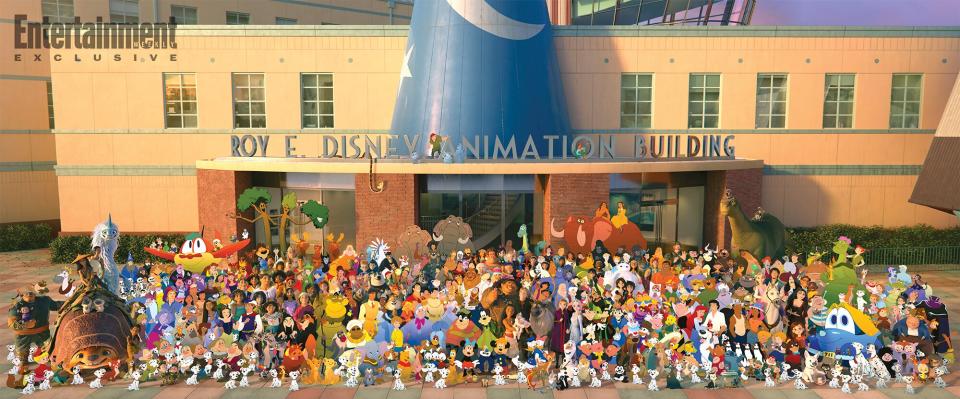
Disney Disney characters past and present assemble for a "class photo" in short film 'Once Upon a Studio'
Trent Correy believes all of Disney's characters are connected by the power of wishing, citing Judy Hopps in Zootopia as she trades farm life for the big city, as well as The Princess and the Frog's Tiana, who dreams of starting her own business. It's a link he noticed through his work with Dan Abraham, his cohort on the 2020 Olaf short film Once Upon a Snowman.
The duo's latest short, Once Upon a Studio, begins with an appearance from Disney's longest-serving employee, Burny Mattinson, who worked there for nearly 70 years and died at the age of 87 in February. As soon as Mattinson and his starry-eyed intern close the doors to Disney Animation HQ for the day, Mickey and Minnie come to life. Leaping out of their framed portraits on the wall, they call on all the other Disney characters past and present to do the same, 543 in total. Dozens of voice actors reprised their roles to record new dialogue, including Idina Menzel (Elsa), Jeremy Irons (Scar), Jodi Benson (Ariel), Paige O'Hara (Belle), and Wish's DeBose. Oscar-winning Mary Poppins composer Richard Sherman also crafted a new rendition of "Feed the Birds" — Walt Disney's favorite song — to play over a scene of Mickey gazing up at a portrait of his creator, while a 54-person choir performed a variation of "When You Wish Upon a Star" for the finale of the 10-minute film.
Once Upon a Studio, like Wish, has become a cornerstone for Disney's 100-year anniversary plans, but it wasn't something anyone was asking for. Abraham initially worked in the story department on Wish, helping to develop the look of Star. "We just knew that Wish was going to be more about the future and celebrate themes that Disney has touched on over the years, but it wasn't going to have any of the legacy characters or celebrate the past 100 years," he says. Correy adds: "I remember thinking at that point, Are they just going to release a montage video on YouTube that's like clips? We should do something more."
For eight months during the height of the COVID-19 pandemic, including nights and weekends, the duo worked on the pitch for Once Upon a Studio in secret. "Nobody was in the studio at the time," Correy remembers of that era of lockdowns and isolation. "We would get in our separate cars, go through the drive-thru of Taco Bell, park in the parking lot next to each other, roll our windows down, and talk about what this short could be and what we, as Disney fans, would want to see." Without knowing it, they found something other filmmakers at the studio had been trying to pull off but couldn't quite crack: a good enough premise to get all the Disney pantheon together in one place.
Listening to their pitch over Zoom — which involved Abraham performing the voices of each character over scrolling storyboards, and singing a bit too — Lee was brought to tears. "It really captured, to me, how Disney's a part of all of us," the exec recalls. "It's something we share, and that sharing brings a lot of joy and a lot of connection. What they had done was, in such a sweet, little short [film], connected us all. I could see it instantly."
The mission was to maintain the hand-drawn animation of classic Disney characters, such as Cinderella and Aurora, alongside the CG-rendered likes of Mirabel from Encanto and Raya of the Last Dragon. Like Snow White's forest critters poking their heads out from behind trees and logs at the sound of her voice, animators and artists from across the studio came out of the woodwork to help. "We had people coming up to us daily and sending us emails and texts: 'These characters mean so much to me. Even if I work on it for a weekend, I have to be part of this,'" Abraham explains. One of those individuals was Eric Goldberg, a longtime Disney animator whose first job at the studio was drawing the Robin Williams-voiced Genie for 1992's Aladdin. He returned to draw the beloved character once more, having done so multiple times over the years for similar legacy specials. "The Genie and I have been friends for many years, and to revisit him in this film is always a joy," Goldberg remarks. "He's a guy who just kind of flows out of my fingers. It's not that I don't have to think about it, but it's a comfort fit."
Abraham sifted through more than 16 hours of archived recordings of the late Williams to pick a single (previously unused) line for the short, which sees Goldberg's hand-drawn Genie materializing as Josh Gad's Olaf hums "Friend Like Me" and doodles on a sketch table. Goldberg finds the interaction poetic. "Josh Gad spoke about Robin — about how the Genie inspired him to be a voice for a Disney character, and he was thrilled that he and Robin were going to be in the same scene together in this film," Goldberg reveals. "Well, the same thing happened on the animation side," he adds, explaining that Hyrum Osmond, who animated Olaf for Frozen, returned to work on the snowman while he worked on the Genie. "It all came home that way."
Circle of Life
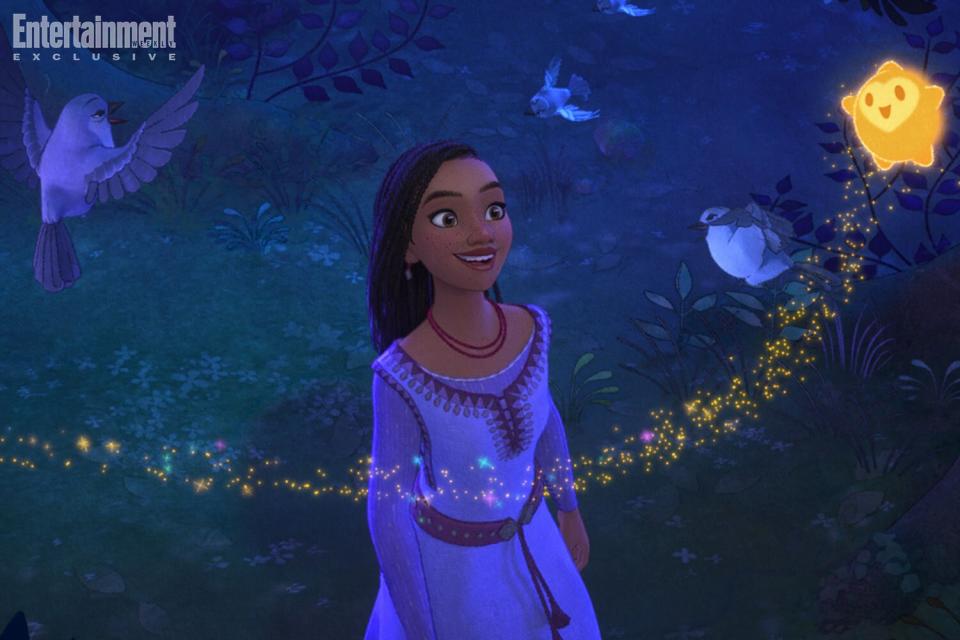
Disney Ariana DeBose's Asha joins Star on a magical adventure in 'Wish'
Goldberg has become a pseudo custodian of hand-drawn animation at Disney, helping preserve the art form's legacy. After the restoration of 1950's Cinderella, which was released on Disney+ in August, the studio announced that Goldberg and Michael Giaimo have been restoring Snow White and the Seven Dwarfs, the very first feature film released by the Mouse House in 1937. "I make jokes about myself being old, but we remember what these things looked like in a movie theater, and there aren't that many people who can say that," the 68-year-old creative says, chuckling. "There was more subtlety in the original color palette, and I think maybe 40 years of turning up the color knob on your TV got people used to more oversaturated color. But we're trying to get back to what we knew the original artwork looked like and what the intentions were."
Aside from a prominent cameo in Once Upon a Studio, Snow White remains an inspiration to the current movie-makers at Disney. That includes Buck and Veerasunthorn, who used hand-drawn animation for the environments of Wish alongside the CG-animated Asha and Magnifico as a nod to the watercolors used for the 1937 film. In a slightly more overt nod to the classic, Asha maintains seven close friends in the kingdom of Rosas. Not only do each resemble one of the seven dwarfs, but their names also share the same initials. Dahlia (Jennifer Kumiyama) boasts brains and glasses like Doc, Simon (Evan Peters) is just as fatigued as Sleepy, Gabo (Harvey Guillén) is a tad Grumpy, Safi (Ramy Youssef) is constantly sneezing, Dario (Jon Rudnitsky) has the same wiggling ears and rosy cheeks as Dopey, Hal (Niko Vargas) smiles as much as Happy, and Bazeema (Della Saba) is as painfully shy as Bashful.
"When the idea came up of [Asha] having a group of friends, we thought, 'Well, it's the 100th anniversary. Could we do seven friends? Can we actually do this?'" Buck recalls of concocting just one of dozens upon dozens of similar legacy nods to the Golden Age era of classic Disney sprinkled throughout the film. "This movie has been so much fun to bring out all these things that mean so much to us. And if the audience doesn't pick up on it, that's okay. Hopefully, the characters stand on their own."
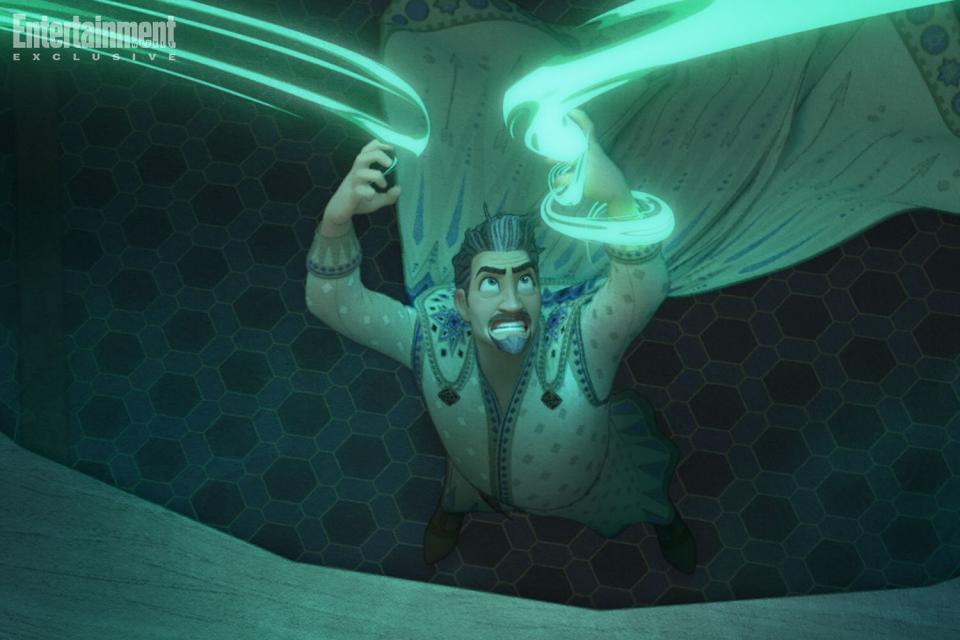
Disney Chris Pine voices King Magnifico in 'Wish'
At the start of Wish, Buck and Veerasunthorn, who first worked together on Frozen, pulled one image from each Disney Animation film and placed them together on a bulletin board to see the entire breadth of the studio's work. One could consider Pine's Magnifico to be a legacy nod, as he evokes the same vibe as the Evil Queen in Snow White or Maleficent in Sleeping Beauty. (And the visuals of his dark magic may remind audiences of another classic Disney baddie.) Lee considers Magnifico to be "a real delicious villain," which is something folks at the studio were craving when thinking of a movie that would embody the 100-year legacy. "I was terrified of being a part of creating it, because how do you compete with some of the incredible villains that have been in the cinematic canon across the board? It's a scary undertaking, but who wouldn't want to try?"
If Magnifico represents old-school Disney, then Asha is very much a modern Disney heroine. Living a perfectly content life with her grandfather and mother, years after her dad passed away, she scores an interview to become the king's personal assistant. At first, she aligns with Magnifico's creed, which is to protect the kingdom's wishes. Once you offer up your wish to him, you forget it so that you don't have to suffer the grief of a wish unfulfilled, as Magnifico once did. But when Asha discovers the sorcerer will only use his magic to grant a select few wishes, leaving the rest to waste away in his castle, she sets out to release them with the help of a magical star that comes to life in response to her wish.
Unlike with their villain, the filmmakers didn't base Asha on any past Disney hero. "We wanted her to be her own person," Veerasunthorn says. "We were inspired by Ariana and what she brings to the recording session. Not only her performance, but as a person." For the West Side Story Oscar winner's first recording session, Veerasunthorn and Buck placed a squishy ball on the end of a selfie stick and waved it in front of DeBose's face as a physical reference for Star. "It was so much fun and so quirky," Veerasunthorn recalls. "That's when we got to know what she could really bring to Asha."
Similar to Anna, Mirabel, or Moana, Lee sees Asha as a modern Disney heroine — she doesn't need anyone to save her. "They have to fight their way through," she says. "To me, the greatest power of a fairy tale is when it's giving you ways to cope through something and watching Asha, very relatably, be that kind of person that's like all of us." Reflective of the film's title and Disney's anthem, Lee points to the power of Asha's wish. "[It's] her journey to say, 'I wish for more for my family, for my community,' and she's going to try to make that happen. She's going to suffer the consequences of those choices, as well as discover the true leader she is inside. She's evolving. In the past, what you'd see a lot of is the character stays the same and others are changed by that character. And that's great, but with modern storytelling, we want to give the challenge to that main character and we want to see her triumph. She doesn't do it alone, no one does in life, but she still has to make the hard choices." It may feel like an ambitious task to make a film that bridges the past and present of a 100-year legacy of storytelling, but having worked with Buck directing Frozen 2, Lee says they would often joke, "If we survived our first musical sequel to a project that a lot of people were like, 'How do you dare do another one?' we can't be afraid to do this."
How Far I'll Go
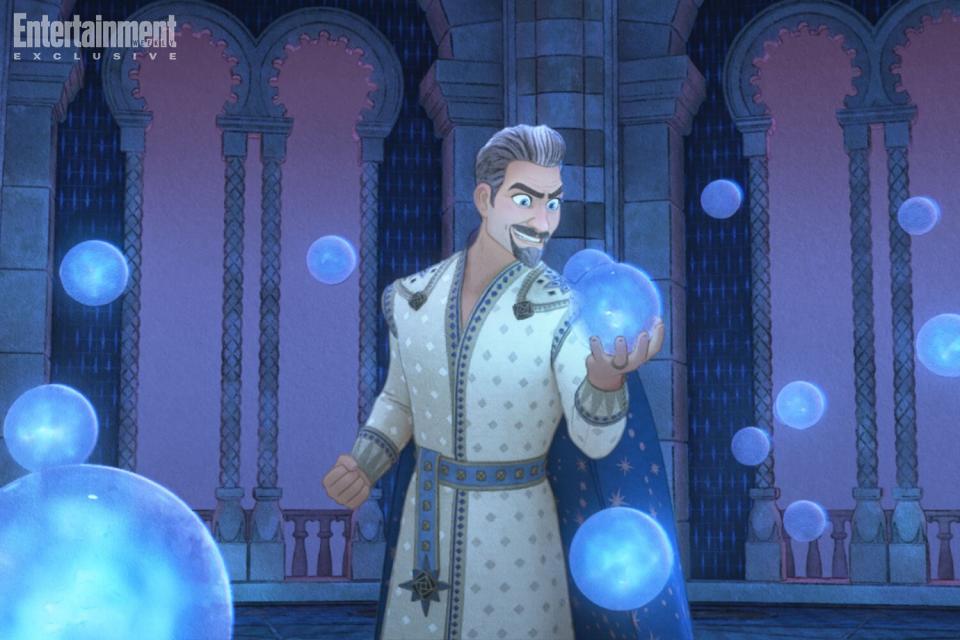
Disney King Magnifico (Chris Pine) oversees the wishes of Rosas in 'Wish'
As much as Disney's anniversary is about looking to the past, Lee has her eyes on the future. Sequels have been announced for both Frozen and Zootopia, but Lee is quick to note that out of Disney Animation's 62 past theatrically released films, only four of them were sequels: 1990's The Rescuers Down Under, 1999's Fantasia 2000, 2018's Ralph Breaks the Internet, and 2019's Frozen II. The priority is still original storytelling. "What we found is if it's driven by the filmmakers and it feels like the right story, it's worth doing," she remarks.
The idea for Frozen 3, she continues, came from Marc Smith, head of story on Frozen II. "Growing it out from there feels right because it's coming with vision, it's coming with purpose." Lee can't say much about what the sequel entails, but when asked if fans should be paying close attention to the current Frozen story being told on the Forces of Nature podcast series, she's hesitant to consider the audio offering canon. "In my head, the films will always stay canon. Anything done outside of that, we give them permission to have their own identity. They may not be canon," she explains. "I still encourage it because I think it's fun to explore. But don't hold us to anything except what we put in those features. That's just me. I don't want to disappoint anyone. But I also want to say I love that other artists get inspired, and I love the idea of the Frozen story."
After Wish, Lee teases further exploration into how hand-drawn animation works alongside CG animation, noting one of her filmmakers is already at work on such a project. But another, perhaps greater experiment is the plan for a Moana animated Disney+ series that acts as a sequel to the 2016 fantasy epic. "One of the things that I don't think is quite what we aim to do here is a Simpsons or a Phineas and Ferb, where it's a series formula," she explains of that project. "The filmmakers tend to work more in a miniseries kind of concept that's closer to features. In some ways, if it's five episodes, I think of it as a five-act play, but that's because of how a lot of us grew up. Some of us here have worked in series, so we help each other. But for me, it's more about the storytelling. No matter what format we're going to do it, it has to be as big, bold, epic, and of the same quality."
"Disney has become one of the most iconic global brands because our stories are made for so many to enjoy, and the elements that help our stories connect, including heart, humor, and optimism, will always be relevant," Bergman adds. "We also have a legacy of innovation to bring that storytelling alive for audiences with so many ways to experience it, whether it's in the movie theater, their home, on stage, through our parks, or with consumer products," the Walt Disney Studios chairman continues. "Technologies will change, the way people consume content will change, but great storytelling is timeless, and that's where we'll continue to see our success come from over the next five or 10 or 100 years."
Appropriately, Lee offers up a wish when thinking about the future of Disney Animation. "My biggest wish is — as I know I'm not that old yet, but I'm getting up there — is that the new generation that we're working with here have everything they need to go to new heights, greater heights," says the 51-year-old. "That's all."
Related content:

